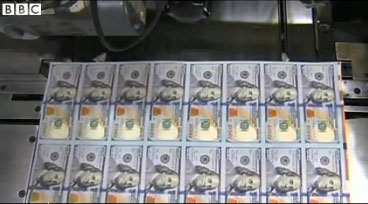
Watch Video
By Matthew Wall and Tom Espiner | BBC Technology News | October 7, 2013
The US Federal Reserve has issued a new hi-tech $100 banknote comprising several new security features.
It includes a blue 3D security ribbon and a bell and inkwell logo that authorities say are particularly difficult to replicate.
These combine with traditional security features, such as a portrait watermark and an embedded security thread that glows pink under ultraviolet light.
The 2010 design was delayed because of “unexpected production challenges”.
The 3D security ribbon – which is woven into the note, not printed on it – features images of 100s that change into bells and move upwards or sideways depending on how you tilt the paper.
Referring to the embedded security thread Chadwick Wasilenkoff, chief executive of security paper company Fortress Paper, told the BBC: “It’s not a small incremental step up for security, it’s a giant leap.”
Tilting also reveals a green bell within a copper-coloured inkwell to the right of the blue ribbon.
In addition, the 100 number in the bottom right-hand corner shifts from copper to green.
The redesigned banknote, which features a portrait of US founding father and scientist Benjamin Franklin, also includes raised “intaglio” printing that gives the notes a distinctive feel, and microprinted words that are difficult to read without magnification.
Forgeries
Over a decade of research and development has gone into the new note, the Fed said, in a joint project with the US Secret Service and the Department of the Treasury.
Advances in design software and high-resolution copying and printing have made it easier for counterfeiters to print fake money and harder for retailers to spot the forgeries.
US authorities say that $100 bill is the most counterfeited of all US banknotes, but accurate figures for the total value of counterfeit cash in circulation are hard to come by.
The US Secret Service estimates that counterfeit bills account for less than 0.01% of the $1.1 trillion (£683bn) of US money in circulation.
It says about $80.7m of counterfeit currency changed hands domestically in 2012, and about $14.5m abroad.
The authorities seized $9.7m in counterfeit cash before it could make it in to the US money supply, and seized $56.8m abroad in 2012.
Bruce Schneier, security expert at BT, told the BBC: “Bills have to be easy to produce cheaply and in large quantities by the government, yet hard to reproduce in small quantities by counterfeiters.
“Making something that costs less than a dollar to produce and over $100 to reproduce is a very difficult problem.”



